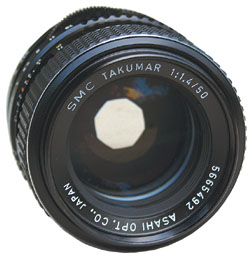 |
|
|||||||
|
Features
New Life For Old Lenses But from the 1950ās well into the 1970ās they were used on many popular SLRs and today, hundreds of thousands of them, maybe even a million or more, are still around ÷ many gathering dust, to be sure, but a myriad of others available to be bought for a song. Cruising eBay one day, I was surprised to see hundreds of these lenses being offered at auction, most going for between $30 to $100. I was one of only two bidders competing for a Super-Multi-Coated Pentax, 50mm Takumar f/1.4 screw-mount lens. The other guy dropped out early and I nailed it for only $40. It was being auctioned by Brooklyn Camera Exchange, a reputable company Iād done business with years ago thatās still going strong. If youāre not into auctions, they also sell direct. (www.brooklyncam.com). In less than a week, my lens arrived in near-mint condition (shipping was only an additional US $6.00) and I then had to figure out how to use it on several cameras I had available. Obviously, I was going to need some adapters and, for those, the man to go to was Stephen Gandy, ćMr. Adapter.ä If thereās a way to adapt almost any lens to work with any camera, he knows how to do it. His web site (www.cameraquest.com) is just chock-full of information on mixed marriages between lenses and camera bodies and his adapters, while pricey, are precision-made, not like a lot of flimsy, badly-machined stuff floating around that can cause you a lot of grief. Pentax had previously sent me a screw-mount adapter for their *ist D so I was set there. That left a Canon 20D and an Olympus E-300. Gandy sent me adapters for both of those. He also sent me an adapter that would allow me to use some of my bayonet-mount Nikon lenses with the Olympus E-300 (I told you he knows his stuff). The only digital camera thatās tough to fit with an adapter for screw-mount lenses is the Nikon. Adapters are available, but they wonāt allow the lens to focus to infinity. Depending on the kind of shooting you do, that may not be a problem. But if you want the full range, Gandy can get you an adapter that has a lens element in it which will do the trick.
Or how about using that same large aperture to selectively focus on flowers, pets or people. The 50mm Pentax Takumar lens I bought has a 35mm equivalent of 75mm to 100mm, depending on which dSLR itās used on÷a perfect focal length for portraits. The picture of the cat was taken using it on an Olympus E-300, from about three feet away at f/4, with the cameraās built-in flash. There are some little inconveniences youāll have to put up with when you use these lenses, but nothing more difficult than the routine photographers have gone through for many years. First, you have to focus manually because the lenses are not linked to your cameraās autofocus system. And you have to physically stop down the lens by turning a ring to your desired aperture, unless youāre shooting wide open. Most screw-mount lenses have click stops so you donāt even have to remove your eye from the viewfinder to look at the aperture ring when stopping down, you just have to know how to count. On my Takumar lens, thereās one click between f/1.4 and f/2.0 and then two clicks between all the other lens openings until you get to f/11 where one additional click takes you to f/16. The upside is that your cameraās metering system can usually calculate the correct exposure automatically. Hereās the drill. Set your shooting mode to Aperture Priority. Then open the lens to its widest aperture. Focus. Then stop down to whatever aperture you want to shoot at. Fire! If the distance to your subject changes significantly, open wide, and focus again. If not, just keep shooting. It quickly becomes second nature. If you want to use a particular shutter speed, switch to Manual exposure and select a speed. Then shoot a couple of test shots at different apertures to find the correct one (hereās where checking the cameraās histogram can be invaluable) and youāre set to go. With some lenses, the cameraās light metering system may consistently over or under expose. If thatās the case, just adjust your exposure compensation to take care of it and leave it at that setting while youāre using that particular lens. If youāre into nostalgia, you can dust off that old light meter and set your exposure manually. Using
half-century-old M42 screw-mount lenses with modern digital cameras
is a fun trip because theyāre a real bargain and produce excellent
images. And thereās something delightfully perverse about using
a forty-dollar lens on a thousand-dollar camera. Sure, you have
to go through a little song and dance to get good results, but it
can make you think about what youāre doing and take you back to
your photographic roots.
Whatās
this T-Mount stuff? You
canāt screw a T-Mount threaded lens directly into a camera that
takes an M42 screw-mount lens or damage will result. However, there
is an T-Mount adapter that allows a T-Mount lens to be used with
M42 screw-mount cameras or M42 screw-mount adapters (is this getting
confusing?) The T-Mount lens screws into an adapter that has M42
threads on the other side. You can then screw that directly into
the camera or into any M42 camera adapter. Do
you really need a ćdigitalä lens? Take that with a grain of salt and some awareness of the laws of physics. The only lenses that may need some redesign are extreme wide-angle lenses, where light rays hit sensors at acute angles, resulting in light falloff and some image unsharpness at the edges. For 35-mm-designed normal and telephoto lenses, itās usually not a critical factor. Hereās why. Lenses are sharpest at their centers and get increasingly soft toward the edges. 35mm camera lenses are designed to cover a larger area than the sizes of most sensors found in current dSLR cameras. When using a lens designed for full-frame 35mm on a dSLR, the softer edges of the lens image extend significantly beyond the smaller picture area of the digital sensor. This results in the digital image being captured by the ćsweetestä spot of the lensö its center. Using good quality film lenses on digital cameras has the potential to produce as good or better images than those made by ćdigitalä lenses that have been designed with image circles just large enough to cover smaller dSLR sensors. ćDigitalä lenses do have some advantages. Because their circle of coverage is smaller than 35mm, they donāt require as much glass and can therefore weigh less. To lighten them even more, most of them have relatively small maximum apertures (you wonāt find many f/2.0 zooms for digital cameras). Finally, they are the only ballgame in town if you want to use extreme wide-angle lenses, many of which are now appearing. Iāve shot images with both film and digital lenses and when large prints are displayed side by side, my professional friends wonāt even make a guess as to which lenses were used. In fact, some shots made with older screw-mount prime lenses are noticeably sharper than images made under identical conditions with digital zoom lenses, not surprising since prime lenses are much easier to design and manufacture to higher tolerances. So
hereās my conclusion. There are good screw-mount lenses and not
so good ones. Most, though, were manufactured with optical resolution
specifications that surpassed what film could record and will give
you perfectly sharp, undistorted, and right-on-color pictures with
digital cameras. Their reasonable prices mean you can well afford
to try a few and judge for yourself. My guess is youāll be hooked
once you see the results from a 400mm lens (600ö800mm on your dSLR)
that might cost only $60.
|
|||||||
|
|
|||||||
|
©
2004 D.C. Publications, Inc. All Rights Reserved. |
|||||||


 There
are over 40 models of about two dozen different camera brands that
used M42 screw-mount lenses (the ć42ä being the designation for
the thread size) and a bunch of third party manufacturers also made
M42 lenses. Screw-mount lenses come as primes (a single focal length)
and zooms. Some of the primes have apertures as large as f/1.2,
simply great for shooting under relatively low light conditions,
such as in sports arenas. Imagine being able to stop action at 1/500th
of a second or faster at a basketball or hockey game by shooting
wide open (or nearly so) at a moderately high ISO from any seat
in the house without worrying if your flash will carry (which, of
course, it wonāt).
There
are over 40 models of about two dozen different camera brands that
used M42 screw-mount lenses (the ć42ä being the designation for
the thread size) and a bunch of third party manufacturers also made
M42 lenses. Screw-mount lenses come as primes (a single focal length)
and zooms. Some of the primes have apertures as large as f/1.2,
simply great for shooting under relatively low light conditions,
such as in sports arenas. Imagine being able to stop action at 1/500th
of a second or faster at a basketball or hockey game by shooting
wide open (or nearly so) at a moderately high ISO from any seat
in the house without worrying if your flash will carry (which, of
course, it wonāt).